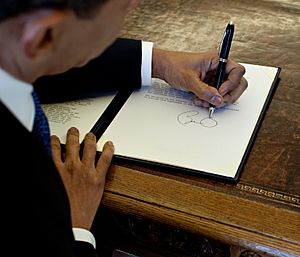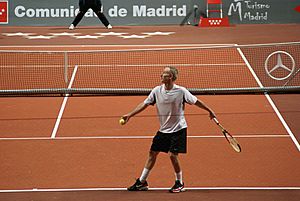Left-handedness facts for kids
Left-handedness means you prefer using your left hand for everyday tasks. This includes things like writing, eating, or using tools. Most people can use both hands for some things. But often, people have a strong preference for their left or right hand when doing specific actions. For example, they might always use their left hand to write, cut with scissors, or brush their teeth.
If someone can use both hands equally well, they are called ambidextrous. If someone finds it hard to use either hand, they are called ambisinistrous.
People don't just have a favorite hand; they can also have a favorite foot! For example, someone might be "left-footed" if they prefer to kick a ball with their left foot.
Most people in the world are right-handed. It's a bit tricky to count exactly how many people are left-handed because everyone has different preferences. But generally, about 5 to 10 out of every 100 people are left-handed.
Contents
Challenges for Left-Handed People
How People Used to See Left-Handedness
For a long time, being left-handed was seen as unusual or even wrong. This is because most people are right-handed, so right-handedness was considered "normal."
In many old languages, like Hebrew, the word for "left" sometimes meant power. However, in many European languages, the word "right" often means "correct" or "true." For example, in English, we talk about having "rights," meaning freedoms or justice.
But the word "left" can also mean "awkward" or "clumsy" in many languages. In French, "gauche" means clumsy. In English, the word "sinister" comes from the Latin word for "left" (sinistra) and means "evil." We even say someone has "two left feet" if they are clumsy, especially when dancing!
Sometimes, left-handed people are called "Southpaws." This term is often used in sports, like boxing.
Tools and Objects Made for Right-Handers
Many everyday items are designed for right-handed people. This can make them tricky or uncomfortable for left-handed people to use. Some examples include certain types of guns, cameras, and even computer mice. While some items are made in left-handed versions, they can sometimes be more expensive.
Scissors Can Be Tricky
Scissors are a great example of something that can cause problems for left-handed people. Most scissors are made for right-handers. When a left-handed person tries to cut with them, they often can't see the line they are trying to cut. Also, the way the blades work is designed for right-handers. This can make left-handed people force the blades open instead of cutting smoothly.
Even if some scissors say they are for both left and right hands, often only the handles are changed. The blades are still set up for right-handed use, which can still cause the same cutting issues.
Writing Can Be Harder

It can be difficult for left-handed children to learn to write if their teacher doesn't offer special help. This is because most writing goes from left to right across the page. This means that a left-handed writer might drag their hand across the words they just wrote, smudging the ink.
In many countries today, children can write with whichever hand feels natural. However, in the past, some children were forced to write with their right hand. Even things like school desks with attached writing boards are often made only for right-handed people. This can make left-handed students sit in uncomfortable positions while writing.
Advantages of Being Left-Handed

Recent studies suggest that being left-handed can actually be an advantage for both animals and humans. Doing things differently from most people can be very helpful in many sports.
For example, in sports like tennis or fencing (fighting with swords), a left-handed player can surprise their opponent. Their movements and angles are different from what most right-handed players are used to.
In tennis, left-handed players hold the racket in their left hand. This means their playing style can be unique. Many famous tennis champions have been left-handed, including Jimmy Connors, John McEnroe, Martina Navratilova, and Rafael Nadal.
Related pages
Images for kids
-
Stenciled hands at the Cueva de las Manos in Argentina. Over 90% are left hands, showing that most people were right-handed.
-
Michael Vick, a left-handed American football quarterback, gets ready to throw the ball.
See also
 In Spanish: Mano dominante para niños
In Spanish: Mano dominante para niños




